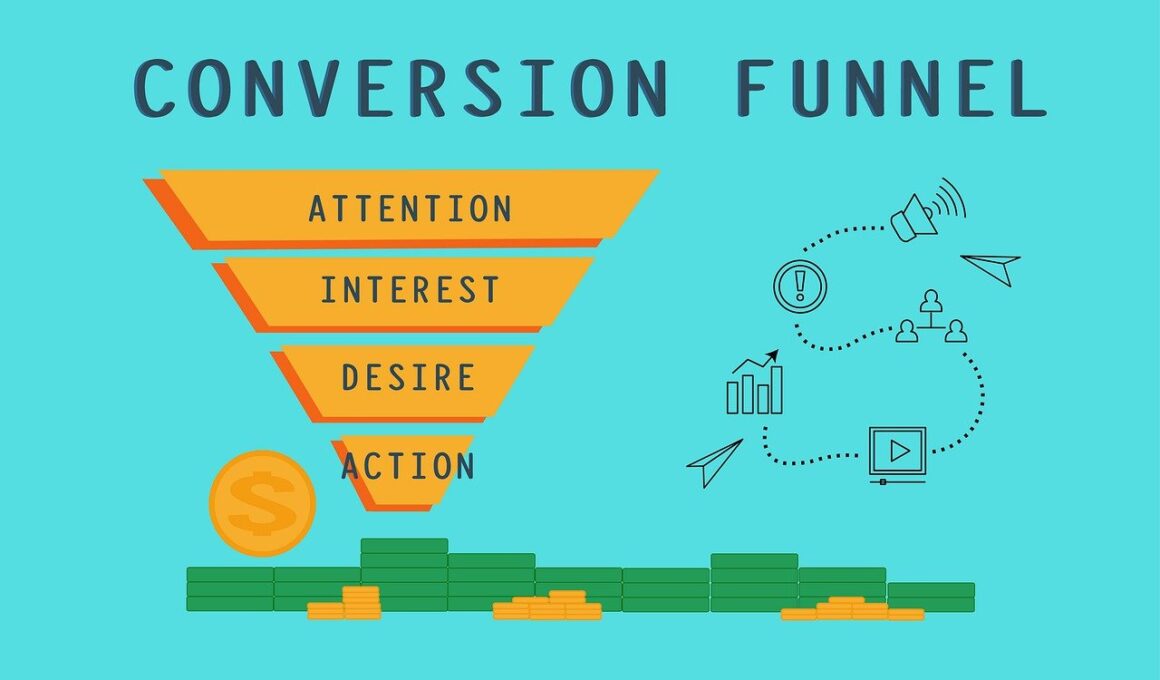Common Pitfalls in Sales Funnel Management and How to Avoid Them
Sales funnel management involves several stages that require careful attention and strategy. Yet, many businesses fall into several common pitfalls. Understanding these challenges is crucial for maintaining a steady conversion rate and achieving sales goals. One frequent error is neglecting audience research. Without knowing your target demographic, marketing efforts may lack focus. This leads to poor engagement and lower conversions. Another pitfall is failing to test different funnel components, which can limit the effectiveness of conversion strategies. Consistent A/B testing helps identify what resonates with potential customers. Additionally, inadequate follow-up can cause potential leads to go cold. It’s essential to maintain contact even after initial interactions. Make use of email sequences to nurture leads and keep them engaged with your offerings. Moreover, many marketers give up too soon. Persistence in following up and refining messaging is vital. Lastly, not analyzing results consistently can lead to repeating mistakes. Implementing metrics to evaluate funnel performance regularly helps identify what requires adjustment. Avoiding these pitfalls leads to better management of your sales funnel, ultimately increasing efficiency and effectiveness in reaching customers.
Another significant pitfall in sales funnel management is overcomplicating the process. When potential customers perceive the sales journey as convoluted, they are more likely to abandon the funnel. Streamlining the steps can significantly improve user experience. This means eliminating unnecessary forms and simplifying checkout processes. Equally important is ensuring consistent messaging throughout the funnel. If the message changes from awareness to consideration stages, it may confuse potential buyers. Use cohesive language and visuals that resonate with your brand to maintain clarity. Additionally, focusing solely on quantitative metrics such as clicks and page visits can misrepresent the funnel’s success. While these numbers are important, qualitative feedback is equally crucial. Gaining insights from actual user experiences can offer a deeper understanding of pain points and potential barriers. Don’t forget to embrace the power of automation in the funnel. Underutilizing automation tools can result in slow responses and missed opportunities. Invest time in discovering effective automation strategies to stay connected and prompt. Thus, assessing both qualitative and quantitative feedback consistently helps enhance the overall funnel experience, ensuring potential customers feel valued and informed throughout their journey.
Neglecting Customer Feedback
Neglecting customer feedback is another critical sales funnel management pitfall. The voice of the customer can provide valuable insights into the sales process. If businesses fail to listen to this feedback, they run the risk of alienating potential customers. It’s vital to collect and respond to customer opinions gathered throughout the funnel stages. Implement surveys or feedback forms at various points to continually gauge feelings and areas for improvement. Take time to analyze these insights to recognize common themes and concerns. This helps identify where customers might be dropping off or feeling lost in the process. Another aspect to consider is not adapting to market changes. Buyer dynamics can shift due to trending demands. Failing to adapt your sales strategies accordingly may leave your business behind competitors who act promptly. It’s crucial to keep an eye on industry trends and adjust your sales funnel strategies. Lastly, not setting clear objectives can cause confusion and lack of direction. Establish specific goals and key performance indicators for each funnel stage to track progress effectively. Ensure that the entire team understands these objectives to foster a united approach toward lead management.
Overlooking mobile optimization is a common issue that can hinder sales funnel management. With increasing mobile internet usage, your funnel must provide an exceptional experience on all devices. Websites that are not optimized for mobile can frustrate potential buyers, driving them away. Testing your funnel on various screen sizes is crucial to ensure accessibility. Improve your mobile experience by simplifying navigation and minimizing loading times. Furthermore, businesses sometimes forget to address customer concerns promptly. When leads experience issues, a swift response can significantly impact their decision-making. Delayed replies can lead to frustration and losses in potential sales. Make customer support readily available through various channels like chat support or social media. In addition, be aware of segmentation throughout your funnel. Diverse segments require tailored messaging and offers to resonate effectively. Using broad messaging can lead to missed opportunities. Identifying and segmenting audiences based on behaviors allows more personalized interactions, which can significantly improve conversion rates. Remember to segment leads efficiently, understanding who they are and their respective needs. This leads to conversations that are more likely to result in conversions, ultimately benefiting overall sales funnel performance.
Failure to Nurture Leads
An often-ignored pitfall in sales funnel management is the failure to nurture leads effectively. Many organizations focus solely on generating leads while forgetting the importance of developing relationships. In this era of customer-centric marketing, maintaining connection is crucial. Utilize email marketing and personalized content to keep your audience engaged. Create meaningful interactions that guide leads through their purchasing decisions and instill trust. Moreover, businesses may mistakenly assume that prospects will automatically progress through the funnel. This is not always true. It’s essential to anticipate that potential customers may need more information before making final decisions. Regular engagement and providing value can significantly influence their journey toward conversion. Also, don’t underestimate the role of social proof. Potential buyers are more likely to convert if they see evidence of positive experiences from existing customers. Include testimonials, case studies, and trust signals throughout the sales funnel. Additionally, consider creating a loyalty program for repeat buyers. This can enhance customer retention and create advocates for your brand. Drawing previous customers back into the funnel ensures that you maintain sales momentum and long-term relationships.
Lastly, not leveraging data analytics can prove detrimental to your sales funnel management. Data plays a critical role in understanding consumer behavior and optimizing processes. It’s vital to track essential metrics such as conversion rates, click rates, and customer demographics. When you neglect these aspects, you may miss identifying trends or shifts in customer preferences. Invest in analytical tools that help gather and interpret this data. Use insights to make informed decisions and inform your strategic planning. Additionally, many sales teams overlook the importance of cross-department collaboration. Effective sales funnel management requires input from sales, marketing, and support teams. Establishing open communication allows for addressing inconsistencies and ensuring alignment across departments. Promoting teamwork and addressing concerns collaboratively enhances the entire funnel process. Another aspect worth mentioning is dealing with potential automation over-reliance. While tools can increase efficiency, they shouldn’t completely take over genuine interactions. Balancing automation with personal touch ensures prospects are nurtured effectively. Remember, it’s human connections that ultimately drive conversions. Embracing both automation and personal interaction can help streamline operations while still building relationships with customers.
Conclusion: Enhancing Your Sales Funnel
Understanding and avoiding common pitfalls in sales funnel management is imperative for success. The journey from prospect to customer involves numerous considerations, and being diligent in addressing potential issues can lead to improved performance. By conducting thorough audience research, testing different components, and maintaining consistent messaging, businesses can significantly enhance engagement. Listening to customer feedback, nurturing leads, and refining mobile experiences are all crucial components of an efficient sales funnel. Adapting strategies in response to market changes keeps your approach fresh and relevant, enabling ongoing success. Metrics and analytics provide a roadmap to guide improvement efforts and ensure clarity throughout the process. Collaboration among departments fosters a cohesive approach, preventing disjointed efforts. Additionally, striking the right balance between automation and personalized communication can improve connection with potential customers. A well-optimized sales funnel not only boosts conversions but also builds lasting relationships with clients. In conclusion, avoiding common pitfalls requires ongoing diligence and a commitment to improvement, ultimately driving greater success for businesses in today’s competitive landscape. Consider investing the time and resources necessary to enhance your funnel management strategies for long-term benefits.
By taking proactive measures to address these pitfalls, sales teams can achieve substantial improvements in their funnel performance. Key factors involve focusing on customer needs, providing exceptional experiences, and analyzing results regularly. Make adjustments when necessary to keep your funnel aligned with market dynamics and user preferences. The importance of adaptability cannot be overstated in this ever-evolving digital landscape. Be open to learning from both successes and failures, leveraging insights to refine your approach continually. Remember, the goal is not only to close sales but to create a satisfying and memorable journey for potential customers. Providing valuable content, timely follow-up, and relevant offers throughout the funnel establishes trust and loyalty. Seek to understand your customers genuinely, addressing their pain points and enhancing their experiences at every touchpoint. Emphasizing the human aspect of customer relationships should remain a priority. Building authentic connections fosters better trust and encourages ongoing engagement with your brand. Utilizing automation wisely, maintaining communication, and gathering vital feedback will help enhance the overall customer experience. Ultimately, effective sales funnel management paves the way for lasting success and growth in the competitive market.


